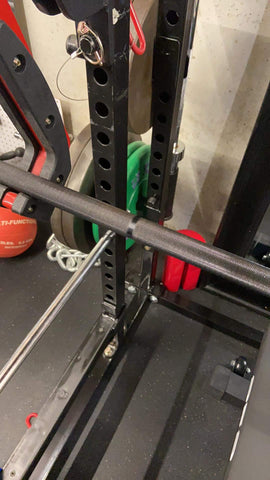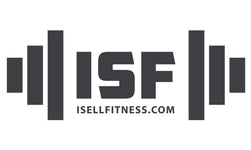
How to Maintain, Clean, and Care For a Barbell
Barbell maintenance is a must if you own a barbell. But what does that mean exactly?
If your barbell finish is starting to wear or rust, there are some step you can take to help maintain its finish. For basic barbell maintenance to clean a bar or to remove rust, you will need a nylon brush (we use a kitchen scrub brush with a long handle), some 3 in 1 multipurpose oil, and some type of rag, preferably lint free. To note a metal brush can damage barbell finish, and would only be recommended as a last resort, or on bare steel bars (bars without coating.) Bars that have a Cerakote (ceramic) finish will for surely scratch if a metal wire brush is used. To play it safe, always start with a nylon brush and evaluate the results from there.

The first step is to clean the barbell. If you use chalk, chalk works by trapping in moisture (from your hands) to give a better grip. It's great for your grip, terrible for your bar since if the chalk is left on the bar, the moisture is also going to remain and that causes corrosion. If you have chalk on the bar, start with the brush and go over the bar, removing as much chalk or other dirt as possible. If you already have some rust, try going over it with the brush until it is removed. You can then apply some oil to any stubborn spots as well and go over the spot with the brush working in the oil to help remove chalk, rust, or dirt. Repeat this process until the affected areas are cleaned. If you do use chalk, the more frequently it is cleaned, the better your finish will last. Ideally, chalk should be cleaned after each use.

If the above is not working, and rust is being stubborn, as a last resort, get yourself some metal polish. Metal polish is great for removing rust from chrome, and it may also work for other finishes, however it is very corrosive to most other finishes, and will likely remove some of the finish. Apply a very tiny amount of metal polish to the affected area and work it into the affected area with the brush. You may want to get a separate, thinner profile brush, to use with the metal polish. This is a last resort method as it will likely also remove finish so the less polish used, across the least area to get the job done, the better. Work it into the affected area and be sure to throughly clean the area (and brush) afterwards to remove all metal polish residue. Reapply 3 in 1 oil to the area after polish removal.
After you clean up the bar with the brush and 3 in 1 oil, you'll want to oil the entire bar shaft to give it some protection. Just apply some oil to the shaft and work it across the bar with the brush or some type of cloth. You don't need a ton of oil, a light coating will work. This step is something which should be done on a semi regular basis, the oil acts as a protectant to help reduce finish wear and prevent rust. If you want to know how often you should clean your barbell in this manner, that is a difficult question to answer as the environmental climate for each situation may be different. We would likely recommend a process that is monthly for most people, but your specific requirement may differ.

While you've got the 3 in 1 oil out, you might as well lube your sleeves. Stand the barbell vertical, apply a few drops of oil between the bushing and the bar shaft, spin the shaft for a few minutes to allow the oil to work itself down through the interior of the sleeve. Repeat on the other side.
If your sleeves are seized up, and adding the oil as mentioned above, does not work, then you will need to open up your barbell to clean and lube it. ISF barbells use a snap ring design, there will be two as a fail safe method in the case of one failing, and we would recommend the ISF snap ring pliers to very easily remove the snap ring. We will address the steps to open up the barbell in a future post, but for now if you have some moderate mechanical ability, opening up a barbell is very easy. As a pro tip, take the barbell apart, place components in the order removed, then simply reverse the order when putting it all back together. Videoing the tear down process helps in case you get stuck on reassembly. We recommend a lithium grease to lube the interior parts if you go ahead and open up the bar. To note, grease is more viscous than oil, and so spin will seem less under an unloaded bar packed with grease, but with weight on the bar the spin will be smooth. Grease will last much longer than simply using the 3 in 1 oil to lube the barbell. If you simply want fastest sleeve spin, our favorite lubricant is Super Lube Multi Purpose Synthetic Lubricant.
What conditions cause rust?
We have already discussed issues with chalk on a barbell, but what other issues are at work in dealing with rusting on a barbell? By understanding these other factors, it will help you to potentially avoid other issues which might cause corrosion to barbell finish. Environmental factors such as where the barbell is stored and the humidity of the environment can play a role in what happens to bar finish. For example, if a barbell is stored outside, there are factors like weather coming into play. Water in the form of rain, snow, or ice will not be good to a barbell. It is highly recommended to store barbells indoors, and to not be directly exposed to the elements. If storing inside of a house is not possible, the next best location would be a shed or some other fully covered environment with walls on all sides. Leaving a barbell for example outside fully exposed will cause higher rates of finish decay.
High humidity environments are also detrimental to a barbell, as higher humidity means more water vapor in the air. The chemicals in water tend to be corrosive to metal which means they will eat away at finish. If the barbell resides in such a high humidity environment, the best step to take to help reduce bar finish will be to install a dehumidifier. The dehumidifier works to reduce humidity by removing water vapor from the air. Because of the corrosive nature of the chemicals found in water, this will be a net benefit to items which have tendency to corrode.
Oils from our hands are corrosive to barbell finish. One good reason to wipe down barbells after use, even if we do not use chalk, is due to the oils secreted by our hands. The outer layer of our skin contains pores which secrete sweat and oil. These secretions are corrosive to finish, sweat for example is partially made up of salt which is very corrosive to metal, and so it is always good practice to wipe down equipment including barbells after use.
Taking some simple steps as mentioned above can help to prolong the life of your barbell finish. If you're ever in the market for a new barbell, be sure to check out ISF barbells here.
Hope all that helps, but in a last report we've got tons of great brand new barbells for sale.

Leave a comment